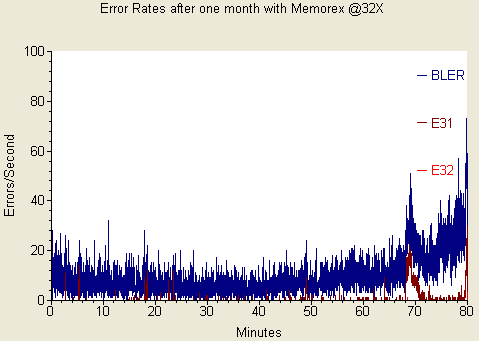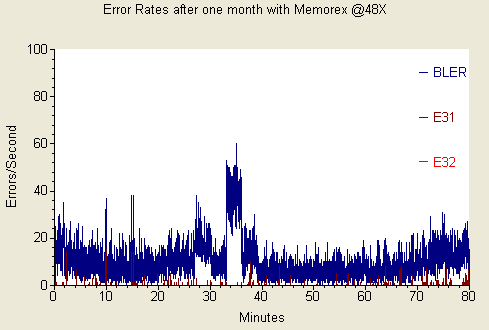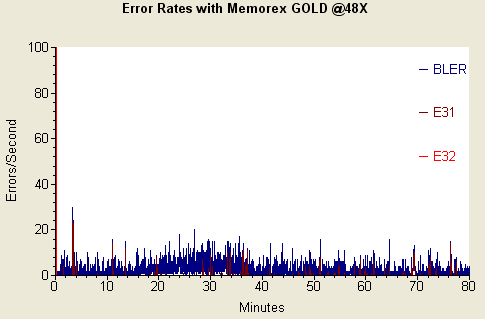1. Introduction
 It was back in 1971 when Memorex made its first steps in the consumer market, producing high quality recording tapes. Throughout the last 40 years or so since its creation, Memorex has offered a wide variety of storage solutions including recordable media for both CD and DVD, flash media, mini discs, diskettes, storage devices such as CD/DVD Recorders, memory sticks, even media cases and labels, and the list keeps getting longer.
It was back in 1971 when Memorex made its first steps in the consumer market, producing high quality recording tapes. Throughout the last 40 years or so since its creation, Memorex has offered a wide variety of storage solutions including recordable media for both CD and DVD, flash media, mini discs, diskettes, storage devices such as CD/DVD Recorders, memory sticks, even media cases and labels, and the list keeps getting longer.
In Memorex Pro Gold Archival CD and DVD Media, Memorex combines a 24-karat gold reflective layer high performance dye and its innovative DuraLayer™ scratch-resistant technology, to deliver archival grade discs. Memorex Pro Gold Archival Media is proven to last up to six times longer than traditional media with a CD archival life of up to 300 years and a DVD archival life of up to 100 years - ensuring the security of photos, music, home movies and important data for generations.

Memorex Pro Gold Archival CD-R Media is available for US$11.99 for a three-pack with storage cases and US$19.99 for a five-pack with storage cases. Memorex Pro Gold Archival DVD-R Media is available for US$14.99 for a three-pack with storage cases and US$24.99 for a five-pack with storage cases.


In order to perform some initial tests on the Memorex CD media Pro Gold series, we decided to burn three of the CD-R Pro Gold discs, measure the writing quality and afterwards, expose them to harsh environmental conditions, especially the sun, for over a month. We then repeated the writing quality measurements to check if any errors had been introduced.
For the burning tests, we used the Plextor PX-760A, writing at speeds of 16X, 32X and 48X. We also burned three ordinary Memorex CD-R 52X at the same speeds, in order to see how a normal disc would perform under such a test. For the measurements, we used the Clover System CDX Compact Disc Analyzer, a high-speed tool to quantitatively measure the quality of a CD.
The quality, as reported by the Clover System CDX Compact Disc Analyzer, is summarized in the two following tables. The first table refers to the quality just after the burning was completed, while the second, after the discs had been exposed for a month as mentioned previously. Since writing quality is to a great degree dependent not only on the media used, but on the burner as well, it is for this reason that we are only interested in the relative change in quality of the discs from before to after the period of exposure to the elements, rather than the absolute quality measurements. In other words, we don't care if the disc quality was good or bad, we simply want to see if there was any (and how much) degradation in quality, from good to not so good or from bad to worse, or if there was no change at all between the initial quality readings to to those after exposure.

First Measurements
The initial quality of the CD-R Pro Gold media, is very good when burned at 16X and 32X, but not so good at 48X, which is reasonable since 48X is quite fast, for safe backups anyway. As you may notice, the quality of the CD-R Pro Gold media is better than CD-R 52X media for all corresponding speeds except at 48X.

Measurements after a month's exposure to the elements
CIRC error correction uses two principles to detect and correct errors. The first is redundancy (extra information is added, which gives an extra chance to read the disc), and the second is interleaving (data is distributed over a relatively large physical area). The CIRC error correction used in CD players uses two stages of error correction, the well known C1 and C2, with de-interleaving of the data between the stages.
The error type E11 means one bad symbol was corrected in the C1 stage. E21means two bad symbols were corrected in the C1 stage. E31 means that there were three or more bad symbols at the C1 stage. This block is uncorrectable at the C1 stage, and is passed to the C2 stage. Respectively, E12 means one bad symbol was corrected in the C2 stage and E22 means two bad symbols were corrected in the C2 stage. E32 means that there were three or more bad symbols in one block at the C2 stage, and therefore this error is not correctable.
What we saw was that there wasn't a great difference with either the Pro Gold Archival CD-R Media or the standard Memorex CD-R 52X after one month's ordeal in harsh conditions. Obviously, one month isn't a long enough period, but the results are nonetheless interesting. If anything, some measurements produced slightly better results. For example, in the two tables above, for standard Memorex CD-R 52X media, there's a definite improvement in the TOT E32 count at 32X and 48X writing speeds. What was noticeable was that the Pro Gold media is of a better quality to start off with, so it is reasonable to expect it to have a better overall performance, although at 48X, it produced the worst results of all. It would be best then, to keep writing speeds to 32X and below.
In the following pages, the results are presented analytically for each disc and speed.
2. 16X Tests
BLER (Block Error Rate) is defined as the number of data blocks per second that contain detectable errors, at the input of the C1 decoder. Since this is the most general measurement of the quality of a disc, you will find BLER graphs for all media tested below. If you click on the images, you can see a more detailed table, indicating error levels.
The Red Book specification (IEC 908) calls for a maximum BLER of 220 per second, averaged over ten seconds. Discs with higher BLER are likely to produce uncorrectable errors. Al low BLER shows that the system as a whole is performing well, and the pit geometry is good. However, BLER only tells us how many errors were generated per second, and it does not tell us anything about the severity of those errors.
Memorex CD-R 52X

Click for the full graph

Click for the full graph
Memorex Pro Gold CD-R 52X

Click for the full graph

Click for the full graph
From the graphs, there is no real, visible difference. The data blocks per second that contain detectable errors (BLER) however, appear to be more, especially for 52X CD-R media. The Pro Gold series, appears to restrict the error rate from increasing.
3. 32X Tests
BLER (Block Error Rate) is defined as the number of data blocks per second that contain detectable errors, at the input of the C1 decoder. Since this is the most general measurement of the quality of a disc, you will find BLER graphs for all media tested below. If you click on the images you can see a more detailed table, indicating error levels.
The Red Book specification (IEC 908) calls for a maximum BLER of 220 per second averaged over ten seconds. Discs with higher BLER are likely to produce uncorrectable errors. Al low BLER shows that the system as a whole is performing well, and the pit geometry is good. However, BLER only tells us how many errors were generated per second, and it does not tell us anything about the severity of those errors.
Memorex CD-R 52X

Click for the full graph

Click for the full graph
Memorex Pro Gold CD-R 52X

Click for the full graph

Click for the full graph
Both media reported a difference in error rates, more so with the CD-R 52X media, especially at the outer edge of the media surface (from the 70 minute mark onwards). In case of the Pro Gold disc there is a slight difference, at the end of the reading area, while the spike at the beginning might be a quirk of the software, with the same spike being produced with the CD-R 52X disc in its initial measurement but wasn't present in the after measurement.
4. 48X Tests
BLER (Block Error Rate) is defined as the number of data blocks per second that contain detectable errors, at the input of the C1 decoder. Since this is the most general measurement of the quality of a disc, you will find BLER graphs for all media tested below. If you click on the images you can see a more detailed table, indicating error levels.
The Red Book specification (IEC 908) calls for a maximum BLER of 220 per second averaged over ten seconds. Discs with higher BLER are likely to produce uncorrectable errors. Al low BLER shows that the system as a whole is performing well, and the pit geometry is good. However, BLER only tells us how many errors were generated per second, and it does not tell us anything about the severity of those errors.
Memorex CD-R 52X

Click for the full graph

Click for the full graph
Memorex Pro Gold CD-R 52X

Click for the full graph

Click for the full graph
48X writing speed is not recommended, if you want to make safe buckups, and this test confirmed this. Here, we see major differences, in comparison to the lower burning speeds, especially with the Gold series disc.